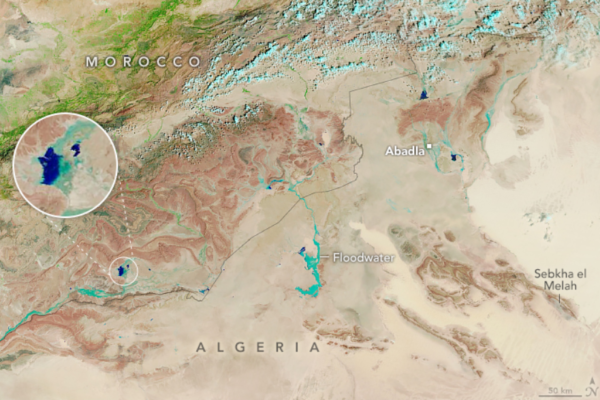Recently, the world’s largest non-polar desert, the Sahara Desert, has experienced a series of heavy rainfall events. In Morocco, at the northern edge of the desert, unprecedented heavy rainfall has led to the surprising phenomenon of “desert turning into a lake,” causing floods not seen in decades. Some countries at the southern edge of the desert have also experienced rainfall several times more than usual.
It is well known that the Sahara Desert is one of the most arid regions on Earth. While this vast expanse of sand occasionally receives rain, it typically only gets a few inches of precipitation each year, mostly concentrated towards the end of summer, making it difficult to have larger scale rainfall events. However, in September this year, an unexpected heavy rainfall broke this pattern. A low-pressure system crossed the northwest Sahara, bringing rare heavy rainfall to parts of the southeastern Moroccan desert.
Officials in Morocco stated that several regions in the southeast of the country usually receive less than 250 millimeters of rainfall annually. However, in September this year, the rainfall over two consecutive days exceeded this level, leading to severe floods in some areas. The small village of Tagounite, only 450 kilometers from the capital Rabat, was among the worst hit, receiving over 100 millimeters of rain within 24 hours.
Houssine Youabeb, a meteorological official in Morocco, said, “We haven’t seen this much rain in such a short period in 30 to 50 years.”
The aftermath of the heavy rain left behind stunning scenes: floodwaters rushing out from sand dunes and oases, flowing through desert vegetation. The Iriki Lake, Morocco’s largest national park located within the Iriki National Park, which had been dry for 50 years, was filled with rainwater.
In the desert town of Merzouga in Morocco, the rare floods carved out lakes of various sizes on the rolling sand dunes. The broad expanse of Lake Neithea reflected the silhouette of palm trees on the shore, resembling a beautiful painting. Satellite images taken by NASA in the region highlighted the traces left by the floods more effectively in false color mode, showcasing the new lakes formed in large areas of the northwest Sahara.
In fact, Morocco has been experiencing drought for six consecutive years, leading farmers to often leave their lands fallow and cities to enforce water restrictions. However, the recent heavy rainfall in parts of Morocco and neighboring Algeria has also triggered floods, resulting in over twenty fatalities and causing road closures and infrastructure damage in southeastern Morocco, significantly impacting normal daily life for residents.
Youabeb mentioned that the weather system responsible for this rainfall, known as an extratropical cyclone, could potentially alter the weather conditions in the region for the coming months or even years due to the substantial moisture in the air leading to increased evaporation and subsequently more storms.
An extratropical cyclone is a large-scale low-pressure system active in mid-latitude regions of the Earth, also known as a “frontal cyclone.” Unlike tropical cyclones, extratropical cyclones are cold-core systems associated with fronts, with diameters ranging from hundreds to thousands of kilometers.
Additionally, unusual rainfall has been observed at the southern edge of the Sahara Desert this year. Satellite images show that the typically arid regions along the southern edge of the desert have experienced frequent thunderstorms recently, resulting in the emergence of green vegetation in the usually barren desert. Data from the National Oceanic and Atmospheric Administration (NOAA) shows that some areas in countries like Niger, Chad, Sudan, and even as far north as Libya have received precipitation exceeding four times the normal levels since mid-July this year.
On October 7, the latest global water resources report released by the World Meteorological Organization highlighted that abnormal climate patterns are making global hydrological cycles more unstable and unpredictable, with many regions facing increasingly severe water-related challenges such as floods due to excess water or droughts, and the rapid alternation between dry and wet periods causing disasters.

